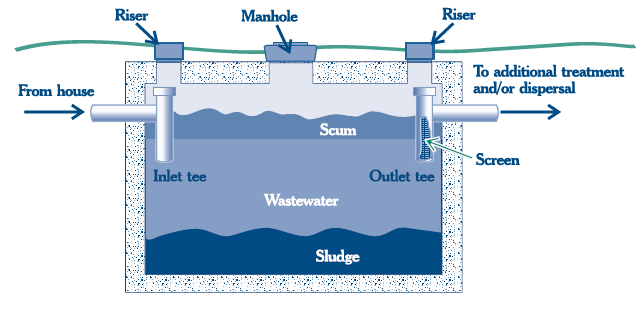FAQ
Have Questions?
Our goal is to help educate you how your septic system operates, how to maintain it, and how to properly care for all components of the system. We cover some basic questions below and more in depth information can be found in the EPA’s Homeowner’s Guide to Septic Systems.
Below is a diagram of how a basic single compartment septic system operates.

In this diagram, waste flows from the house into the inlet tee which directs the waste to the bottom of the tank, minimizing disruptions to the existing contents of the tank. Solids/sludge will sink to the bottom of the tank, while scums (soaps, detergents, fats, oils) will rise to the top of the tank. The middle layer of wastewater will rise into the outlet tee. Once in the outlet, the wastewater will filter out a soil treatment area, ultimately being naturally filtered back into the earth by the soil.
Check out this interactive diagram from Texas A&M showing a more detailed view of how a septic system works.
The frequency of pumping service can vary based on many factors such as number of people living in the home, water usage, tank size, and how well the system is cared for. Most septic systems should be pumped between every 2-5 years, but the best answer is that your tank needs to be pumped when your specific system needs to be pumped.
Because there is no conclusive evidence that suggests the use of additives in a septic system is necessary. As long as a system is designed, maintained, and operated properly, it will have everything it needs to work correctly.
For more information see this handy guide from the National Small Flows Clearinghouse.
After pumping, the tank will be completely empty of all scum, sludge, and wastewater. Depending on water usage, tank size, and number of people in the home, the tank will refill after approximately seven to ten days. A septic tank will always have an operating level of water in it, which is about 10″ from the top of the tank. Without this the tank would not be a conducive environment for bacteria to grow and break down the solids, and the water would never reach the level of the outlet to the soild treatment area.

Request A Quote Today
...
Reach Us
Location :
11537 County Road 18 Fort Morgan, CO 80701
Email :
delmarsepticservice@gmail.com
Phone :
(970) 673-3894
